How to deal with root rot in cannabis plants
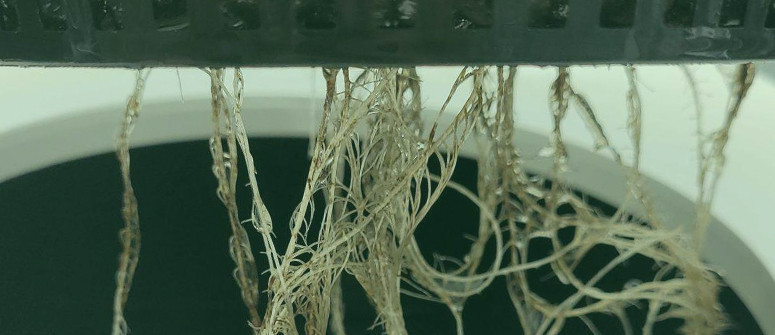
It's every cannabis grower's mission to keep the roots of their plants healthy and happy. If your crop falls victim to root rot, you need to act fast to remedy the issue—if it isn't too far gone. Better is to prevent the issue from occurring in the first place. Read along to find out how to keep your plants free from this condition.
Contents:
Little is more traumatising to a cannabis grower than root rot. A broad term describing the deterioration of the root system, root rot is a merciless condition that usually signals the end of a grow—but not necessarily. If the right methods of treatment are applied, or if sufficient prevention methods are taken to ensure the roots never undergo undue stress, root rot needn't be an issue in your next grow-op. In this article, we'll acquaint you with the causes and symptoms of root rot, before offering tips on treatment and prevention. Arm yourself with the knowledge you need to ensure a successful grow.
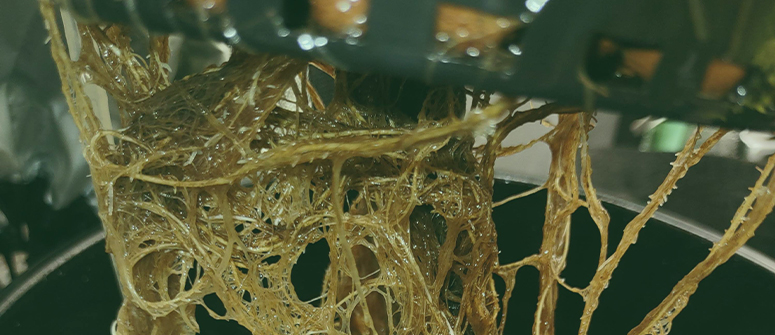
What is root rot?
Root rot, in cannabis and other plants, occurs when certain fungi or fungi-like organisms, such as Pythium, Armillaria, and Fusarium, attack the root systems of vulnerable specimens. There are numerous potential causes of root rot in weed plants, but all of them result in a lack of oxygen in the growing medium, which subsequently causes roots to quickly degrade.
What causes root rot in cannabis?
Given the above, anything that prevents adequate air circulation in the root zone can cause root rot. Specifically, overwatering is a fast track to root rot, especially in young plants; when their root systems have yet to be sufficiently developed, plants can fall victim to all manner of plights. At the same time, even well-developed specimens will struggle to survive in waterlogged conditions.
In addition to reckless overwatering, root rot can also be due to a lack of drainage holes in the growing container, or simply a medium that is unsuitable for growing cannabis. Growing media high in clay and other dense materials will prevent oxygen from circulating the root system, leading to rot. Certain other environmental factors, such as high temperatures, can spur the growth of Pythium and other microorganisms.
Once conditions are suitable for the above-mentioned fungi and fungi-like organisms to strike—i.e. anaerobic conditions—it won't take long for the roots to stop absorbing any nutrients and become listless and slimy.
A note on hydroponics: While most of the above causes occur in soil-based growing media, hydroponic operations can also fall victim to root rot. If there is not enough oxygen in the water, due to improper temperature or lack of aeration, the roots will indeed begin to rot. Furthermore, light leaks in the reservoir can lead to conditions that support root rot.
Does root rot spread?
If growing several plants in the same garden plot or hydro system, then, yes, root rot can spread from one specimen to another. For this reason, among others, it's often recommended to grow in individual containers.
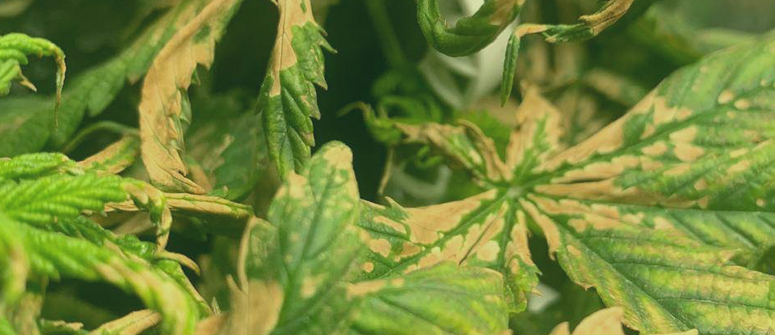
Signs of root rot in cannabis
As root rot begins in the root system, it may be difficult to recognise the issue before signs manifest in the aerial parts of the plant. In addition to slimy, brown roots, the following symptoms can show up as root rot progresses:
- Foliage will begin to yellow and develop brown or burnt-looking spots. Eventually, leaves will wither and die off.
- The entire plant will take on a wilted, droopy appearance. Growth will stall, and the specimen will lose its vigorous appearance.
- Plants will not absorb any additional water you give them.
- The growing medium and runoff may smell musty or mouldy.
- Branches may begin to dieback.
- Certain root rot-causing organisms, like Pythium, can be spread via fungus gnats, so these specimens may also signal that your plants have root rot.
Can cannabis plants recover from root rot?
If root rot has only just begun to strike a plant, then you may well be able to save it. However, once the roots have been affected, they cannot be saved. So your plants must have at least some healthy roots in order to sustain life in a new medium. This is why it's important to practise good prevention techniques, and to look out for signs of root rot in marijuana so you can treat it early if it does arise.
How to treat root rot in cannabis plants
So, you think your plant has fallen victim to root rot. Now is the time to act. If growing in a container or soil bed, you will need to very carefully remove your plant from its current medium. If you're growing hydroponically, stop your system and remove the plants.
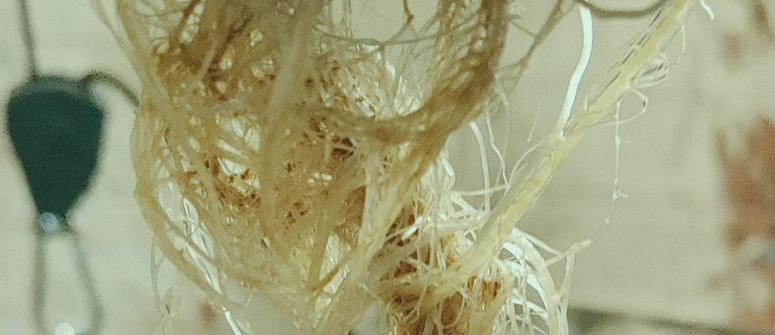
Wash and prune the roots
First things first—very gently rinse the roots under cool water until they are no longer slimy and covered in grime. If the entire root system is brown and mushy, you likely will not be able to save your plant. If there are still some white roots, though, you can do your best to optimise their health by trimming away the dead or dying roots using a clean pair of shears. Even if just a few healthy roots remain, you may still be able to save your plants.
Repot plants in an unaffected medium
As mentioned, one of the main causes of root rot is an inhospitable medium. So, make sure you prepare your new growing container or unaffected garden bed with cannabis-specific soil—i.e. that which is rich, but light and airy. To increase drainage and aeration, consider adding perlite to the substrate. Also, if using a growing container, make sure it has sufficient drainage holes. To do away with this issue entirely, and to ensure the overall health of your plants, consider growing in fabric pots—these are much less likely to contribute to root rot.
If growing hydroponically, thoroughly clean your reservoir, tubing, etc., and ensure your water is properly aerated, such as by using an air stone. Also, make sure the reservoir is kept in complete darkness with no chance of light making its way in.
Add beneficial bacteria
There are a couple schools of thought regarding post-root rot care; one suggests adding a 3% hydrogen peroxide solution to the water. Although this works to kill the harmful microorganisms that attack cannabis roots, it will also kill any beneficial organisms. As such, it's often recommended to instead amend your substrate with beneficial bacteria, such as Bacillus strains, that can help to aerate the soil as well as protect the roots from harmful microorganisms. Beneficial bacteria can also be utilised in a hydro system to create a healthy balance of microorganisms in the root zone and reservoir.
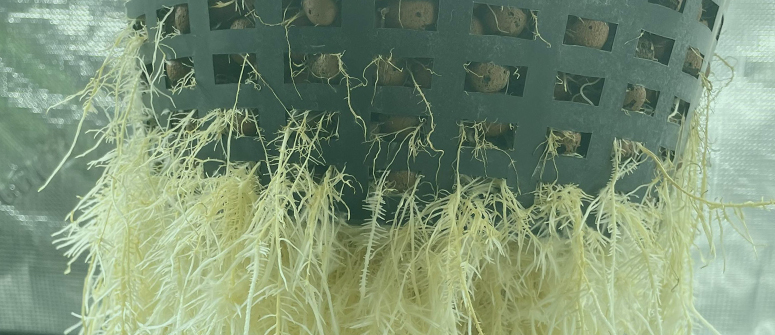
How to prevent root rot in cannabis plants
The phrase "prevention is better than cure" is one we invoke often, but nowhere does it apply more than in the realm of root rot. Although you can save plants from root rot in some circumstances, there is also a high likelihood that your crop won't make it any further. To prevent this horrible fate from occurring, do your best to maintain an ideal environment for your plants by considering the factors below.
Avoid agitating the root system
The root systems of cannabis plants, especially of young specimens, are extremely delicate and vulnerable to all manner of pathogens and forms of stress. So make sure not to handle them any more than you have to (such as when transplanting), and do your best to minimise any physical damage or exposure to bacteria, fungi, etc.
If growing hydroponically, allow young plants to establish a healthy biofilm on their root system before changing the reservoir, as the stress caused by this can be too much for the roots to bear.
Water once, but water well
Watering your cannabis plants may seem straightforward, but it is arguably one of the biggest pitfalls among new cannabis growers in particular. Though you want to provide sufficient hydration to support the growth of your plants, overwatering is a killer and will quickly thwart your entire operation.
To prevent this from occurring in a soil grow, water your plants thoroughly, soaking the entire medium, then allow the medium to dry out fully before doing so again. If growing in containers, stick your finger into the soil to ensure it's completely dry, or lift up the pot itself to judge how saturated the medium is.
Ensure plants have proper drainage
As poor drainage is a common cause of root rot, you must ensure your medium is thoroughly aerated and has the right structure to house cannabis plants. Also, as alluded to above, your growing containers must be able to drain the water properly. If growing in plastic containers, ensure you have plenty of drainage holes on the bottom, and that the pots themselves are positioned in a way where water doesn't pool. Consider using runoff trays and propping your plants up if necessary. Growing in fabric pots can help to take the hassle away, and will make certain the root system doesn't outgrow the container to boot.
If growing in a garden bed, drainage can also be an issue. Even if the soil structure is adequate, a plot that is too small or houses too many cannabis plants can lead to stagnant water and issues like rotting.
Cleanliness is crucial
Given that bacteria, fungi, oomycotes, and other pathogens are ultimately responsible for destroying the root system, you must do everything in your power to prevent them from coming into contact with your plants. By ensuring a hygienic grow with fresh soil or a clean reservoir, you can limit the presence of these pesky pathogens to begin with.
As many microorganisms can live dormant in a soil medium until conditions are ideal, we do not recommend reusing soil from a past cannabis grow, unless the soil has been properly sterilised then amended with nutrients.
Moreover, as many forms of fungi and bacteria feed on dead and decaying plant matter, ensure your plants, whether indoors or outdoors, do not come into contact with any material that may transmit fungal spores or pathogens to their growing medium and root system. If growing hydroponically, it is particularly important that your reservoir is 100% clean and doesn't contain any errant plant matter.
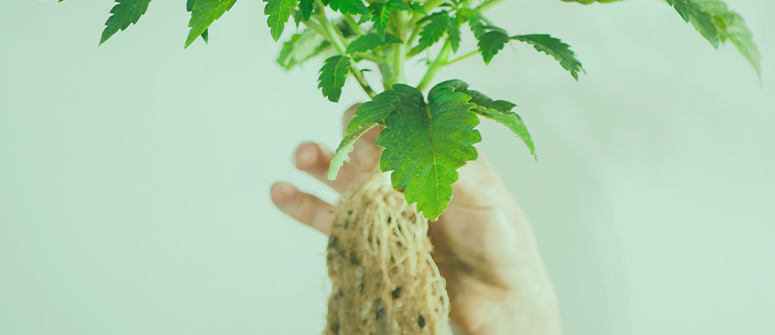
Keep the temperature optimal
Especially if growing hydroponically, it's essential to maintain a reservoir temperature of around 18–20°C to prevent root rot from setting in. Soil-grown plants can usually handle slightly higher temperatures, but the growing medium should still not be exposed to excessively warm or cold conditions.
Don't let root rot spoil your harvest
Though it's certainly not a welcome presence in any grow, root rot needn't destroy your cannabis crop. With good prevention techniques, and by keeping a close eye on the health of your plants, you can work to avoid this issue from striking your precious specimens. If root rot does happen to rear its ugly head, act quickly to prune affected roots and get your plants back on their way to good health!


